Fish that change gender!
The Planet Earth we live in is covered in oceans,rivers and lakes
which are filled with an abundance of living organisms. Similar to the
numerous creatures that live on land or in the air, the creatures that
inhabit the oceans and rivers are also very fascinating. Some are
beautiful and others are ugly and even weird or bizarre. The physical
attributes of some of these creatures are indeed unique and mind
boggling.

Dwarf angelfish |
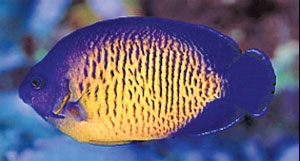
Dwarf angelfish |
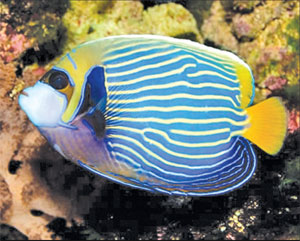
Emperor angelfish |

Queen angelfish |
Today we like to focus your attention on a species of fish that is
not only beautiful but also fascinating due to its special capabilities.
Some of you who are into breeding fish as pets or for relaxation may be
aware of a colourful species of fish known as Angelfish and even know of
its ability to change gender . However, let's explore the deep waters
and learn more about the eye-catching species of fish to enhance our
knowledge about the oodles of wonderful creatures that share the planet
with us.
Do you know that there are over a hundred different species of
angelfish living in the southern hemisphere? You may have seen some of
them. There are two kinds of angelfish;those that live in the freshwater
rivers of of south America and those that inhabit the salty oceans. The
freshwater and marine angelfish differ in size and colour. While the
freshwater angelfish has a more triangular shape and grows to a few
inches in length,the marine angelfish can grow up to 12 inches (the same
length as a big ruler) and generally have very brightly coloured
markings but the exact colours depend on the angelfish species.
Freshwater angelfish are native to the Amazon basin and are also found
in the rivers running off it. Freshwater angelfish inhabit the cleaner
waters and prefer to be in temperatures between 25 and 30 degrees
centigrade.
They lay between 100 and 1,000 eggs which hatch in just a couple of
days. Freshwater angelfish tend to lay their eggs on a flat leaf or an
underwater log. The baby angelfish (known as fry) remain attached to the
eggs for another week and feed off the remaining yolk in the egg sack.
When they are bigger at a week old, the angelfish fry detach from their
eggs and become free swimming. It is at this stage that the baby
angelfish begin feeding from nutrients in the water and on plants.
The triangular shape of the freshwater angelfish, means that the
angelfish is able to hide more easily amongst the aquatic plants in the
water. Wild freshwater angelfish have very distinctive dark stripes that
run vertically down their bodies, giving the freshwater angelfish the
ability to blend in to its surroundings. Freshwater angelfish usually
breed for life and it is often found that if one of the angelfish
parents dies, then the remaining angelfish parent has no interest in
breeding.
Freshwater angelfish feed on smaller fish and invertebrates in their
natural environment as well as eating particles of food found in the
water. The freshwater angelfish is preyed upon by larger species of
fish, birds and marine mammals.
Marine angelfish are generally found in shallow reefs in depths of up
to 50 metres. Marine angelfish are reported to be almost fearless and
are noted to be inquisitive and curious towards divers. Some species of
marine angelfish are solitary by nature where other species of angelfish
form territorial mating pairs or even groups. The groups of marine
angelfish usually have one male and a number of females. Unlike the
freshwater angelfish, marine angelfish lay their tiny eggs straight into
the water. The angelfish eggs float in the sea, becoming mixed in with
the plankton, until they hatch. Unfortunately, a vast number of marine
angelfish eggs are inadvertently eaten by those many animals that feed
on the plankton in the water.
Marine angelfish graze on algae on coral reefs and rocks as well as
eating smaller fish and crustaceans such as shrimp and small species of
prawn. Adult marine angelfish are preyed upon by sharks, marine mammals
and humans, but the young and smaller marine angelfish are eaten by many
different species of animal both in the water and those based on land
(such as birds).
Despite the fact that their names are the same, freshwater angelfish
and marine angelfish are not thought to be closely related.Of the two
different kinds the marine angelfish are well known for the bright
colours and patterns on their bodies. Marine angelfish vary in colour
and size depending on the species , although it is known that the
patterns and colours of marine angelfish change drastically as they get
older. It is believed that these colour changes indicate the position of
the fish, within the marine angelfish social hierarchy.Fish are
generally remarkable creatures, and they have beautifully adapted to the
harsh life in the oceans.
Even when groups of fish do not have enough males, or females, many
species simply change their gender to ensure reproduction. This change
is controlled by social interactions. Being dominant, or subordinate,
controls the gender hormone levels, and will trigger a change in some
situations.When an individual changes from male to female, we call this
protandry. When it changes from female to male, it is called protogyny.
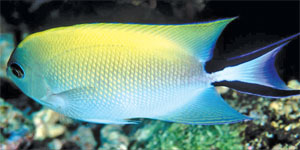
Blackspot male and female angelfish |
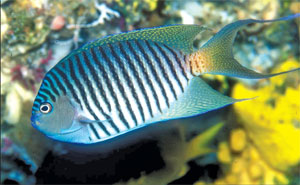 |
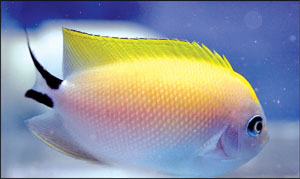 |
| |
Blackspot angelfish (Genicanthus melanospilos) and dwarf angelfish (Centropyge
spp.) are just two species that have the ability to change gender when
the need arises. They can change from female to male when the dominant
male of the group is lost, thus they are protogynous species. When a
male is lost from a harem, the largest female changes sex within a
couple of weeks!
The Blackspot Angelfish is found in tropical marine waters feeding of
plankton that is picked from the currents a few meters of the surface
bottom. With a highly-flared tail, the Swallowtail Angelfish is also
referred to as the Blackspot Angelfish, Blackspot Lyretail Angelfishand
Spotbreast Angelfish.
Male Blackspot Angelfish are blue-white with small black bars on the
body. The dorsal, anal and caudal fins have yellow spots. The tail fin
is crescent shaped. Female Blackspot Angelfish are yellow on top and
blue below. The crescent-shaped tail is blue with a black stripe on the
top and bottom edges.The species grows to 18 cm in length. There are
several species of Blackspot Angelfish: Lemonpeel Angelfish: (Centropyge
flavissimus) Makes a good pair, and a trio of one male and two females
can be kept in no less than a 100 gallon aquarium. Cherub Angelfish: (Centropyge
argi) Good for pairing and two or more females can be kept together, but
only as long as the tank is at least 50 gallons in size and they are all
added at the same time.
Centropyge (common name: Dwarf angelfish) is a genus of marine
angelfishes. The genus is the largest within the Pomacanthid family,
comprising over 30 described species. Species in this group do not
exceed 15 cm (approximately six inches) in length and live in haremic
structures with one dominant male and multiple females. Although it is
hard to identify their gender; females are often shorter and more round
finned (which is more obvious when looking at a group of specimens)Like
many other reef fish and all marine angelfish, species in this genus are
protogynous hermaphrodites, meaning that they start their adult lives as
females and the dominant individual in a group can change to a male
within days. A reversal of this sex change is possible if the social
status of the individual changes, it is however a process that requires
much more time (weeks to months).
Recently, it has been found that Centropyge ferrugata males can
change back to females after being dominated by a larger male. They can
reverse to a female state within 47-89 days.
Not only can they change gender , they can also change their
appearance .Male C. ferrugata angelfish have a specific coloration of
the dorsal fin. After the male to female transition, even the dorsal fin
changed back to that of a female.
Scientists found that the species P. flavivertex, P.. aldabraensis
and P. cyanotaenia can change gender in an environment where there are
only males or only females.
This basically means that when 2 females are placed together, one
becomes male (or the other way around). This process of changing gender
is called hermaphroditism. Generally all marine angelfish species are
known to be protogynous hermaphrodites.
[Fast facts]
* Both the freshwater angelfish and the marine angelfish are known to
be relatively difficult fish to keep in household aquariums, as both
types of angelfish require very specific water conditions.
* Marine angelfish are perciform fish of the family Pomacanthidae.
They are found on shallow reefs in the tropical Atlantic, Indian, and
mostly western Pacific oceans. The family contains seven genera and
approximately 86 species.
* Many species of marine angelfishes have streamer-like extensions of
the soft dorsal and anal fins. The fish have small mouths, relatively
large pectoral fins and rounded to lunate tail fins.
*The largest species, the gray angelfish, Pomacanthus arcuatus, may
reach a length of 60 cm (24 in); at the other extreme, members of the
genus Centropyge do not exceed 15 cm (5.9 in). A length of 20 to 30 cm
(7.9 to 12 in) is average for the rest of the family.
* Most marine angelfishes restrict themselves to the shallows of the
reef, seldom venturing deeper than 50 m (160 ft).
* The Queen angelfish, grows to be 45 cm (18 in). With neon blue and
yellow scales, with iridescent purple and orange markings, surprisingly
it is not conspicuous, and actually hides very well, and is very shy.
* Another interesting fact about angelfish is that they have an
occupation in the fish world. Most of them act as 'cleaners' for other
fish. They pick parasites and dead tissue from the body of other fish.
* The angel fish are among the most brightly coloured fish of the
sea. You can also see them in home aquaria. People prefer to keep them
because of the interesting patterns on them. These patterns help them to
hide from predators. Often, the young ones are differently coloured than
the adults.
At night, when these fish become inactive, their colours may change.
Among the better-known species are the black and gold angelfish of the
Indo-Pacific, the French angelfish, Pomacanthus paru (or P. arcuatus), a
black and yellow species of the Atlantic, and the queen angelfish (Holacanthus
ciliaris), a blue and yellow fish of the Atlantic. They can be found in
the freshwaters of South America, in warm seas and coral reefs and can
grow up to a length of 17 inches.
*They usually swim alone or in pairs. They have thinly compressed
bodies and a strong spine located in the lower part of the cheekbone.
Their diet consists mainly of sponge and algae.
* The closest relatives of angelfish are the butterflyfish from the
Chaetodontidae family. The easiest way these two groups of fish can be
differentiated is that angelfish posses spines of their gill covers that
are lacking in butterflyfish.
Facts and pix: Internet |

